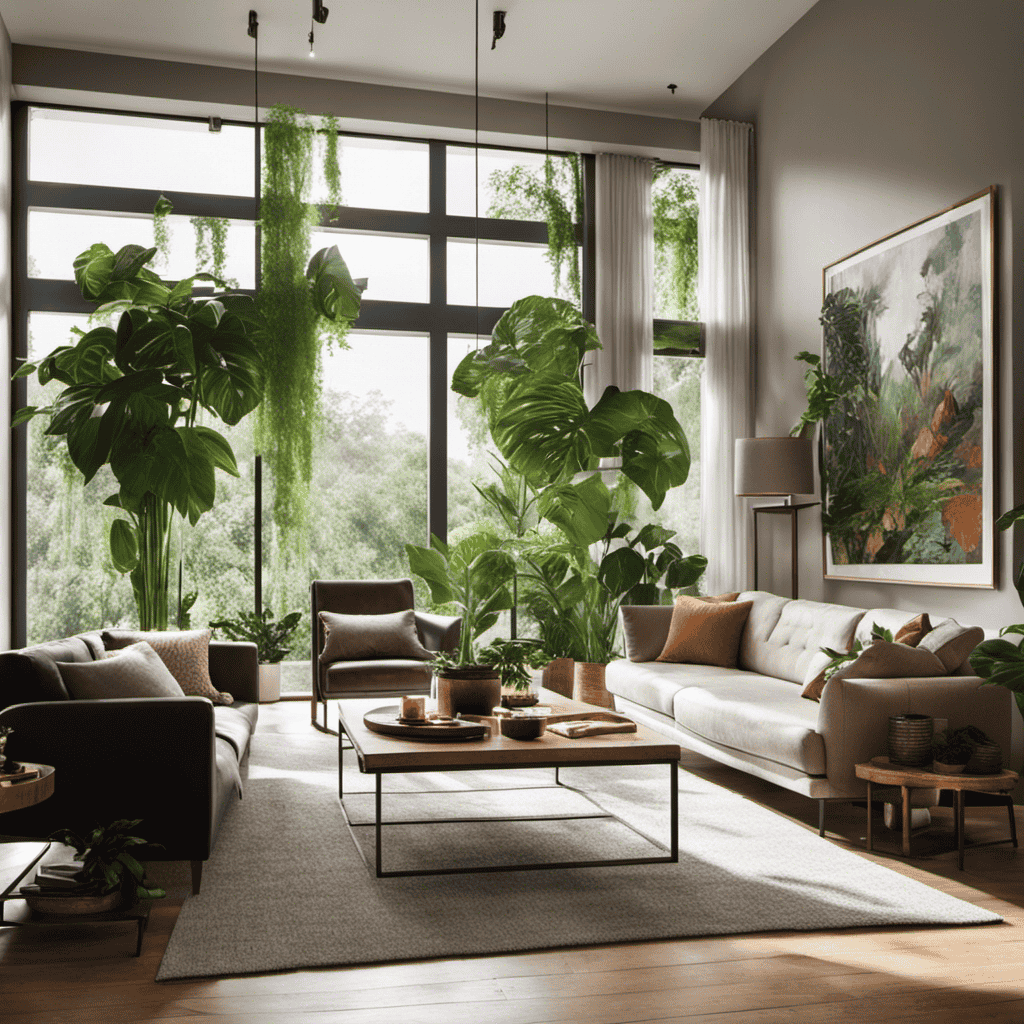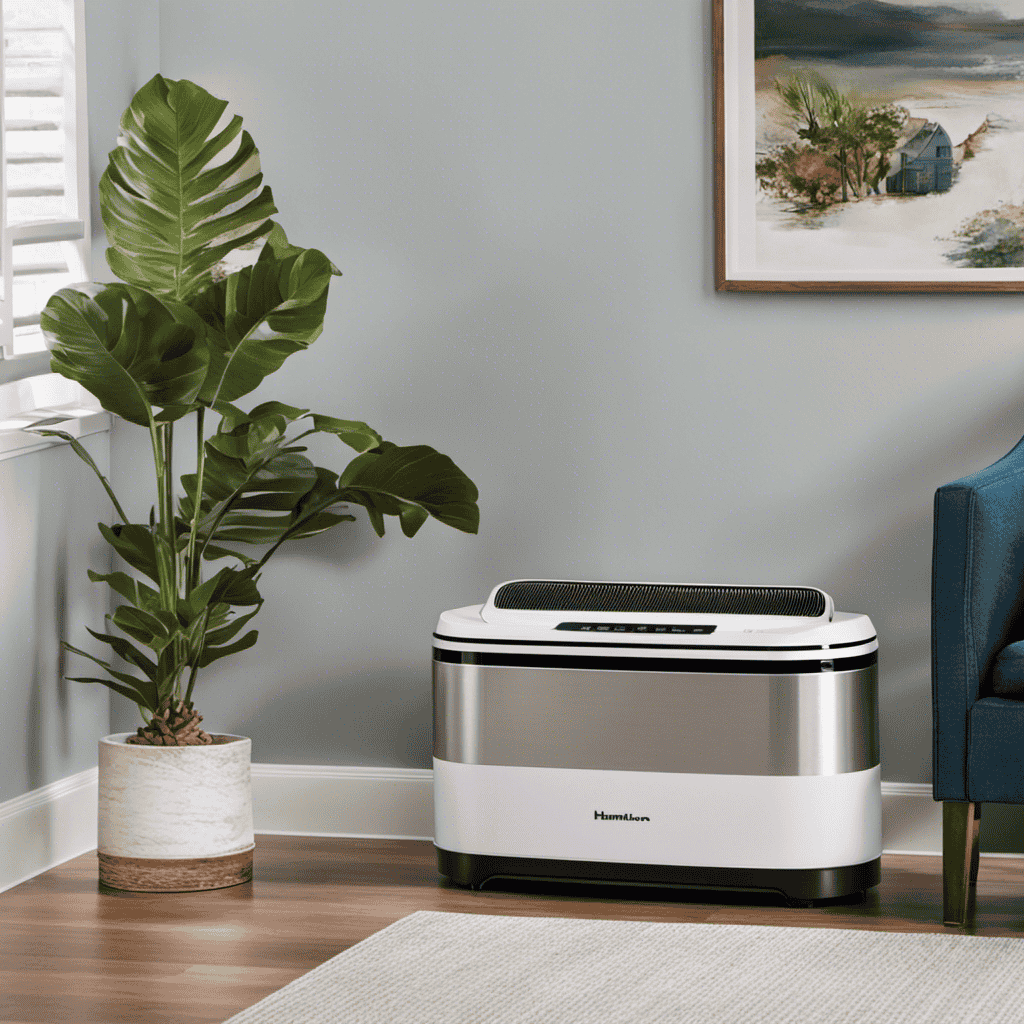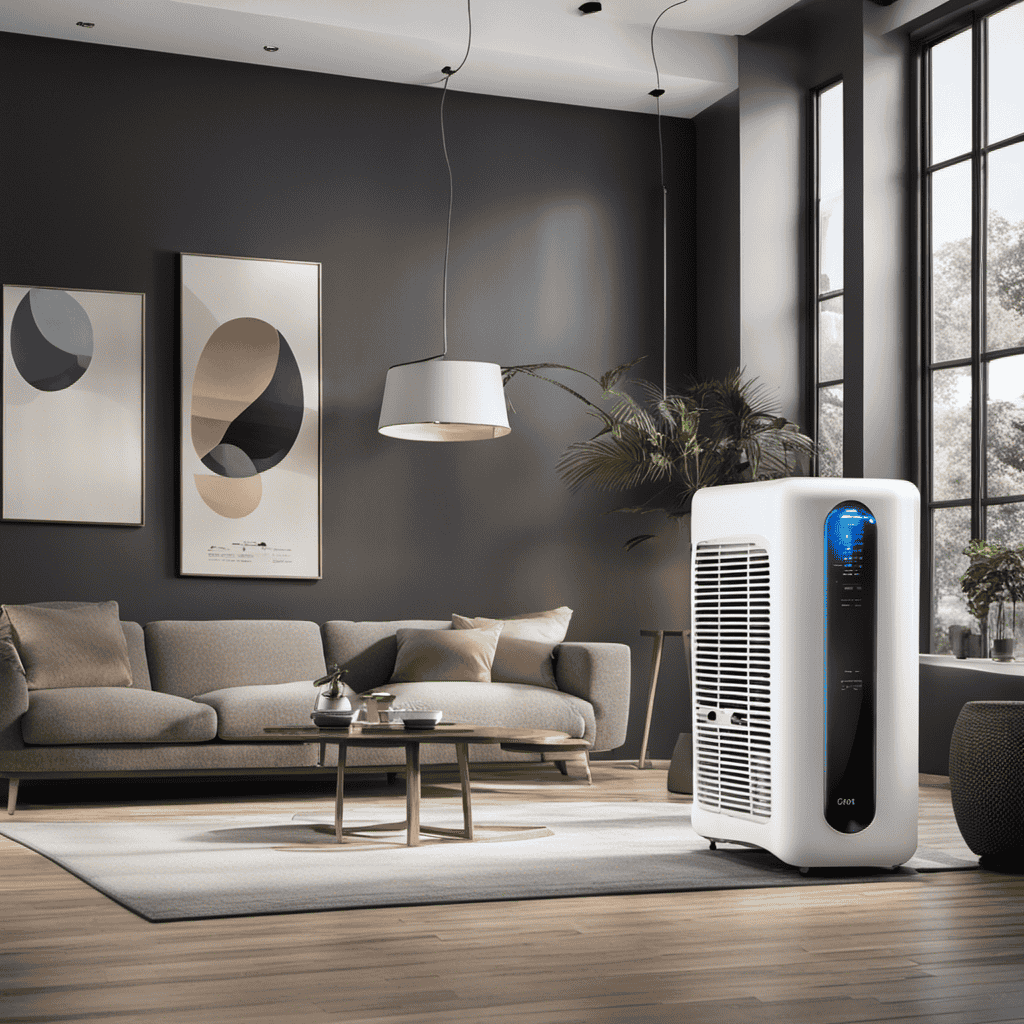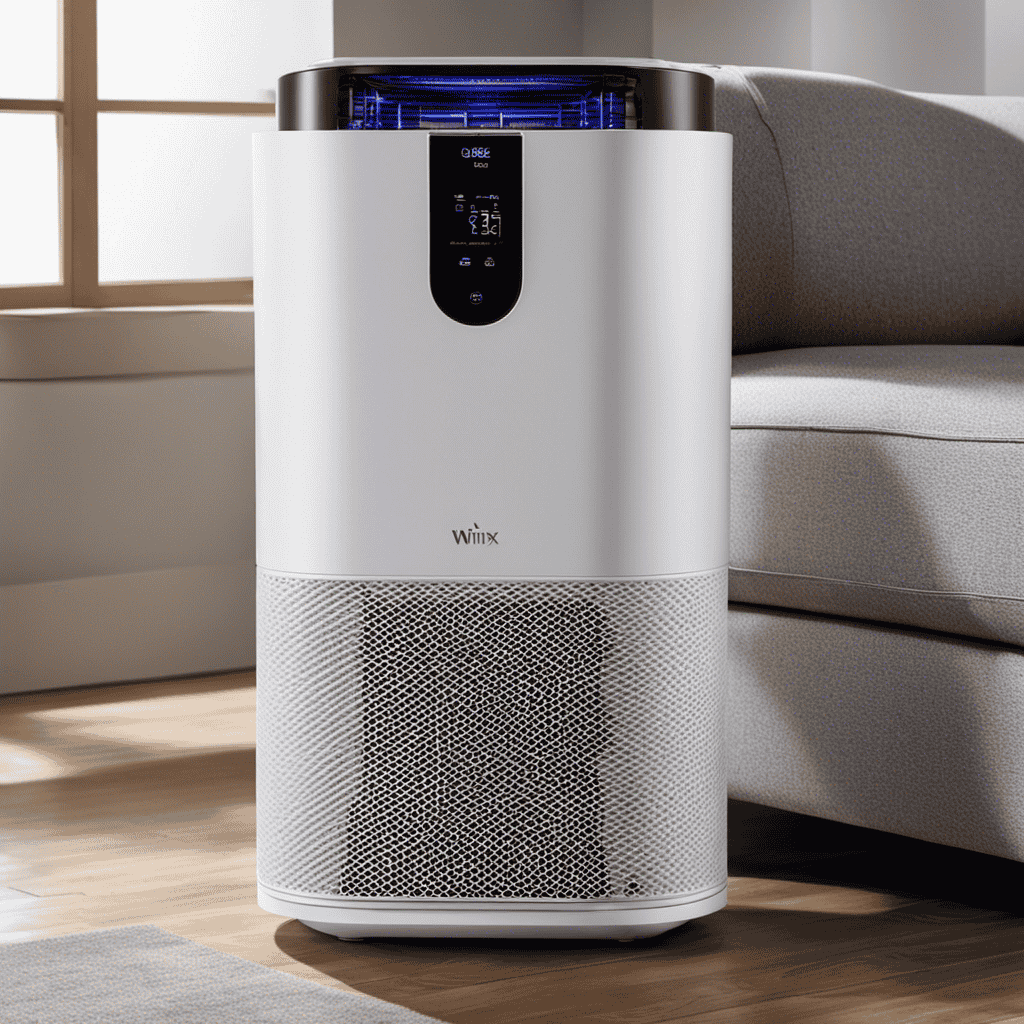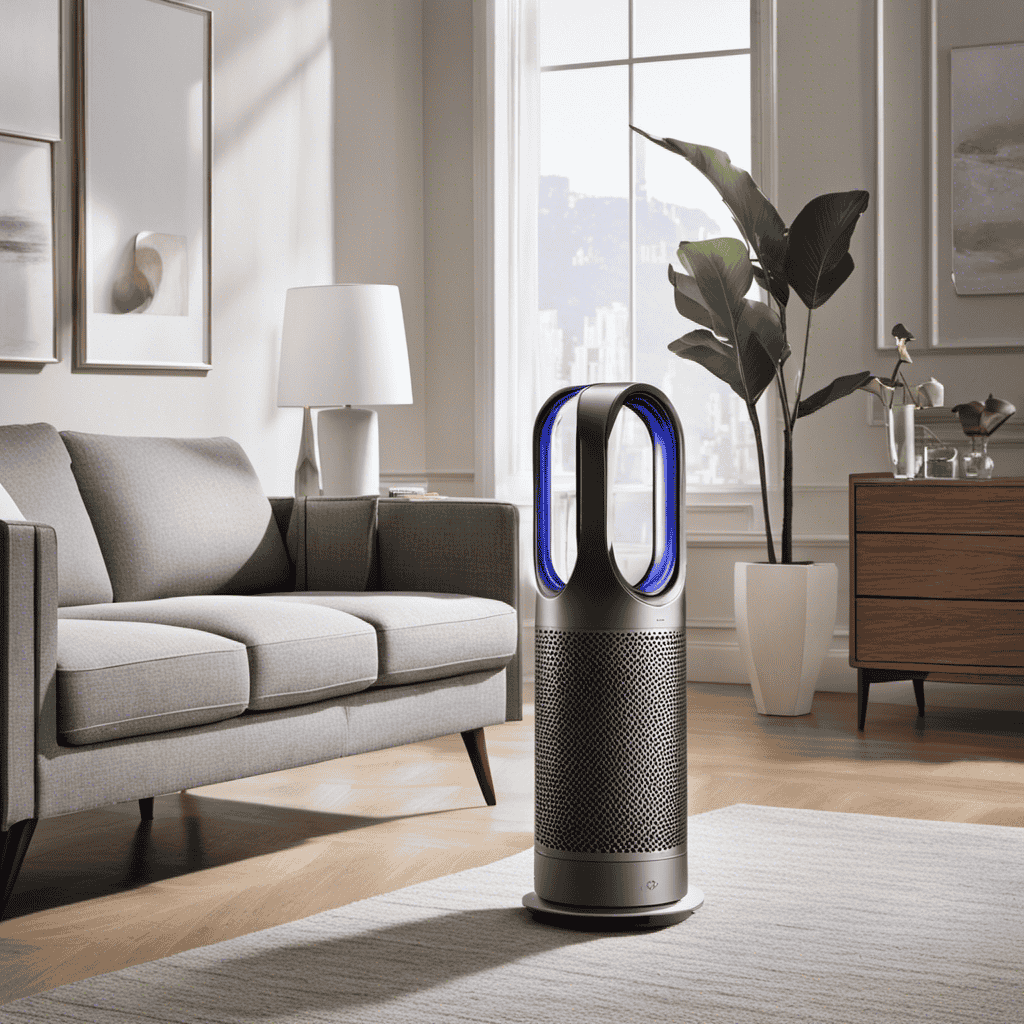As a passionate indoor gardener, I have always been intrigued by the ability of plants to cleanse the air in our living spaces. In this article, I will investigate the realm of air-purifying plants and examine which ones are most suitable for indoor environments.
With a detailed and scientific approach, I’ll provide you with the knowledge you need to choose the right plants for your home and offer tips on their care and maintenance.
Let’s embark on this green journey together, and discover the creative ways we can incorporate air purifier plants into our home decor.
Key Takeaways
- Snake plants, spider plants, pothos, and various other air purifier plants can be grown inside homes.
- These plants have the ability to remove pollutants such as formaldehyde, benzene, carbon monoxide, and xylene from the air.
- Air purifier plants promote better sleep, alleviate allergies, and improve the overall indoor environment.
- These plants are low maintenance, thrive in various lighting conditions, and require minimal water.
Benefits of Air Purifier Plants
Air purifier plants have several benefits for improving indoor air quality.
Indoor plants are not only aesthetically pleasing, but they also play a crucial role in enhancing our overall well-being.
One significant benefit is their ability to promote better sleep. Certain plants, such as lavender and jasmine, emit soothing scents that can help relax the mind and body, leading to a more restful sleep.
Additionally, these plants can help alleviate allergies. They absorb harmful pollutants and release oxygen, effectively reducing the presence of allergens such as dust and pet dander in the air.
This can greatly benefit individuals suffering from allergies, providing them with a cleaner and healthier indoor environment.
Incorporating air purifier plants into your home can have a positive impact on both your sleep quality and allergy symptoms.
Best Air Purifier Plants for Indoor Spaces
When it comes to choosing indoor plants, it’s important to consider both their effectiveness and maintenance requirements.
In this discussion, I will provide insights on the most effective indoor plants for purifying the air and their low maintenance options.
Most Effective Indoor Plants
Some of the most effective indoor plants for purifying the air include snake plants, spider plants, and pothos. These plants not only add aesthetic appeal to any indoor space, but they also have the ability to filter out harmful toxins and improve air quality.
Here are four reasons why these plants are a great choice for low light options and adding beauty to your home:
- Snake plants (Sansevieria) are known for their ability to remove formaldehyde and benzene from the air.
- Spider plants (Chlorophytum comosum) are excellent at removing carbon monoxide and other pollutants.
- Pothos (Epipremnum aureum) are effective at removing indoor air pollutants such as formaldehyde and xylene.
- These plants are easy to care for and thrive in low light conditions, making them perfect for indoor spaces with limited sunlight.
With their air purifying abilities and low maintenance requirements, these plants are a must-have for any indoor environment.
Low Maintenance Options
If you’re looking for easy-care options, you’ll love these indoor plants that require minimal maintenance. These low maintenance plants not only enhance the aesthetics of your home but also provide several benefits. They can improve air quality, reduce stress, increase humidity, and even boost productivity. Take a look at the table below to see some examples of low maintenance indoor plants:
| Plant Name | Light Requirements | Watering Needs |
|---|---|---|
| Snake Plant | Low to medium light | Low water |
| ZZ Plant | Low to bright indirect | Low water |
| Pothos | Low to bright indirect | Moderate water |
| Spider Plant | Medium to bright light | Moderate to high water |
These plants are perfect for busy individuals or those with a black thumb. They can thrive in various lighting conditions and require minimal water. With their low maintenance needs, you can enjoy the benefits of indoor plants without the hassle. Now, let’s dive into some care and maintenance tips for air purifier plants.
Care and Maintenance Tips for Air Purifier Plants
To keep your air purifier plants healthy, make sure you water them regularly and place them in a well-lit area. Indoor plants not only add beauty to your home but also provide numerous benefits, such as purifying the air and improving your overall well-being.
Here are some care and maintenance tips for air purifier plants:
-
Watering: It is important to water your plants adequately, but avoid overwatering as it can lead to root rot. Ensure that the soil is moist but not waterlogged.
-
Light: Most air purifier plants thrive in bright, indirect light. Place them near a window where they can receive sufficient sunlight for at least a few hours each day.
-
Humidity: Many indoor plants prefer higher humidity levels. Consider misting them regularly or placing a tray of water nearby to increase humidity.
-
Fertilizing: Feed your air purifier plants with a balanced fertilizer every few months to provide them with essential nutrients for growth.
How to Choose the Right Air Purifier Plants for Your Home
When it comes to choosing the best indoor purifier plants for my home, there are a few key factors I consider.
First, I look for plants that are known for their air purification abilities, such as the snake plant or the peace lily.
Second, I take into account the specific conditions of my home, such as lighting and humidity levels, to ensure that the plants I choose will thrive.
Lastly, I make sure to follow proper maintenance tips, including regular watering, pruning, and cleaning of the leaves, to keep my indoor purifier plants healthy and effective.
Best Indoor Purifier Plants
You can easily grow the best indoor purifier plants in your home. These plants not only add beauty to your living space but also have numerous health benefits.
Here are four indoor plants that are known for their air purifying qualities:
-
Snake Plant: Also known as Mother-in-Law’s Tongue, this plant is great for filtering out toxins like formaldehyde and benzene. It releases oxygen at night, making it an ideal plant for bedrooms.
-
Spider Plant: This easy-to-care-for plant is excellent at removing formaldehyde and xylene from the air. It is also safe for pets, making it a popular choice for households with animals.
-
Peace Lily: Known for its elegant white flowers, the Peace Lily is effective in removing toxins like ammonia, benzene, and formaldehyde. It also helps to improve humidity levels in the room.
-
Boston Fern: This lush green plant is a natural air humidifier and helps to remove pollutants such as formaldehyde and xylene. It thrives in areas with high humidity levels.
Factors for Plant Selection
Now that we know the best indoor purifier plants, let’s discuss the factors to consider when selecting plants for our homes.
Plant placement and ideal growing conditions are crucial for their growth and air purifying abilities.
When it comes to plant placement, it is important to consider the amount of light a plant requires. Some plants thrive in bright, indirect light, while others can tolerate low light conditions. Placing plants near windows or in well-lit areas can provide them with the necessary light for photosynthesis and growth.
In addition to light, the ideal growing conditions for indoor plants include temperature and humidity levels. Most indoor plants prefer temperatures between 60-75°F (15-24°C) and humidity levels of 40-60%. Keeping these conditions in mind will help ensure that our plants thrive and effectively purify the air in our homes.
Maintenance Tips for Plants
Taking care of indoor plants involves regular watering, pruning, and providing the appropriate nutrients for their growth. It is essential to maintain a healthy environment for your indoor plants to thrive. Here are some indoor gardening tips to help you maintain your plants effectively:
-
Watering: Ensure the soil is moist but not waterlogged. Overwatering can lead to root rot, while underwatering can cause wilting.
-
Pruning: Regularly trim dead or yellowing leaves to promote new growth and maintain the plant’s shape. Pruning also helps prevent diseases and pests.
-
Light: Place your plants in areas where they can receive adequate sunlight or artificial light. Different plants have varying light requirements, so research their specific needs.
-
Natural Air Purification Techniques: Indoor plants not only add beauty but also purify the air. Choose air-purifying plants like spider plants, pothos, peace lilies, and snake plants to improve indoor air quality.
Common Air Pollutants and How Air Purifier Plants Can Help
To better understand common air pollutants and how air purifier plants can help, it’s important to educate yourself on the subject.
Indoor air pollution can be caused by various sources such as volatile organic compounds (VOCs), formaldehyde, and benzene, which are released from furniture, cleaning products, and even our own activities.
Air purifier plants play a vital role in improving indoor air quality by absorbing these harmful pollutants through their leaves and roots. They act as natural air filters, removing toxins and releasing oxygen into the environment.
Not only do they help cleanse the air, but they also bring numerous benefits to indoor gardening. They add a touch of greenery, create a calming atmosphere, and even boost our mood and productivity.
Incorporating air purifier plants into our homes can greatly enhance our overall well-being.
DIY Air Purifier Plant Projects for Indoor Gardens
It’s time to explore some DIY projects that can help improve indoor air quality in your garden. Indoor gardening not only adds beauty to your home but also has numerous benefits for your health and well-being.
Here are four DIY air purifier plant crafts that you can try:
-
Terrarium: Create a mini ecosystem in a glass container. Use air-purifying plants like spider plants or peace lilies to filter toxins from the air.
-
Hanging planters: Hang air-purifying plants such as English ivy or pothos in stylish macrame planters. These plants can remove harmful substances like formaldehyde and benzene from the air.
-
Herb garden: Grow herbs like basil, mint, or rosemary indoors. Not only will they add fragrance and flavor to your dishes, but they will also help improve indoor air quality by absorbing pollutants.
-
Vertical garden: Use a vertical gardening system to grow air-purifying plants like snake plants or aloe vera. These plants can remove toxins and release oxygen, creating a healthier environment.
Creative Ways to Incorporate Air Purifier Plants in Home Decor
Incorporating air-purifying plants into your home decor not only adds beauty but also improves indoor air quality.
To display these plants in small spaces, innovative planters can be used, allowing for creative and stylish ways to incorporate them into your home. One option is to use hanging planters, which can be suspended from the ceiling or mounted on the wall, saving valuable floor space.
Another creative idea is to use vertical planters, such as a living wall or a plant ladder, which can be placed against a wall or in a corner. These vertical displays not only add visual interest but also maximize the use of limited space.
Additionally, using small shelves or tabletop planters can be a great way to incorporate air purifier plants into your home decor without taking up too much space.
Are There Any Air Purifier Plants That Are Safe to Grow Inside a Home in California?
Yes, there are safe air purifiers California residents can grow inside their homes. Plants like peace lilies, snake plants, and spider plants are great options. These air purifier plants can help remove toxins from the air, creating a healthier indoor environment.
Frequently Asked Questions
Are There Any Air Purifier Plants That Are Toxic to Pets?
Yes, some air purifier plants can be toxic to pets. It’s important to choose air purifier plants that are safe for pets, such as spider plants, Boston ferns, and areca palms. These plants are also great for small spaces.
Can Air Purifier Plants Remove Allergens From the Air?
Yes, air purifier plants can remove allergens from the air. They improve air quality in offices and can even remove mold spores. It’s incredible how these plants cleanse the air, like a breath of fresh air.
How Often Should I Water My Air Purifier Plants?
When it comes to watering air purifier plants, it is important to maintain a consistent schedule. The frequency will depend on the specific plant and its needs. Overwatering can lead to root rot, so it is crucial to find the right balance.
Can Air Purifier Plants Help With Reducing Indoor Odors?
Yes, air purifier plants can help reduce indoor odors. For example, a study found that the Snake Plant (Sansevieria) can absorb and eliminate harmful pollutants, improving air quality in homes.
Are There Any Air Purifier Plants That Require Low Light Conditions?
Yes, there are air purifier plants that thrive in low light conditions. These plants, such as snake plants and pothos, not only help purify the air but also bring aesthetic benefits to indoor spaces.
Conclusion
In conclusion, air purifier plants are a wonderful addition to any indoor space. Their ability to filter out harmful toxins and improve air quality is truly remarkable.
As I sit in my living room surrounded by these green wonders, I can’t help but feel a sense of peace and tranquility. The air feels crisp and clean, like taking a deep breath in a forest after a rainfall.
I am grateful for the calming presence of these plants, knowing that they are actively working to keep me healthy and refreshed.
